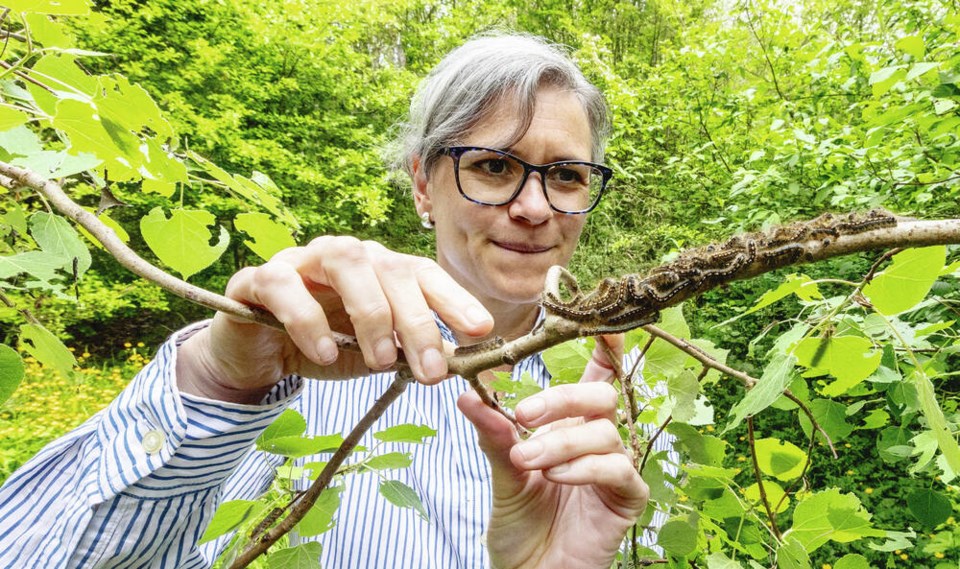Tent caterpillar season is here and millions of the fuzzy creatures are emerging from their silky cocoons to feast on the foliage of trees.
They’re in backyards and on fences and sidewalks and sometimes hitchhiking on your clothing or inching up your arm.
Depending on the tree and your area, the caterpillars will be munching on leaves for the next few weeks and going to ground where they will turn into moths.
But experts say although it’s a heavy year for the forest and western tent caterpillar in the region, it isn’t likely to be a problem for most trees.
Claudia Copley, an entomology collections manager and researcher at the Royal British Columbia Museum, recommends destroying nests of the caterpillars on young fruit trees and low-hanging branches of other deciduous trees, but said anything higher can be left alone.
“The message is if you can’t reach it, then the tree is big enough to handle them,” said Copley.
At the Swan Lake Christmas Hill Nature Sanctuary in Saanich, forest tent caterpillars were having a leaf mega-lunch on the aspens near the parking lot on Tuesday.
“You can hear so many caterpillars munching the leaves overhead that the descending droppings sounds like a soft rain,” said executive director Cara Gibson.
She said the caterpillars are considered social — even “gregarious” — and feed in large groups as a way to dilute the effects of predation and parasitism.
The caterpillars generally do not inflict permanent damage to healthy trees. “In fact, the damage they do to the leaves can allow additional sunlight to reach the under-story and a greater mix of plant species is able to grow as a result,” Gibson said.
Mountain and white ash, birch, willow, poplar and oaks — as well as plum, apple and cherry — are preferred by the caterpillars. Moths lay their eggs on branches in the fall and the caterpillars emerge to make large silky pouches in the spring when the temperature rises.
They are not an invasive species — forest and western tent caterpillars are native to British Columbia and other parts of North America, said Copley.
The forest tent caterpillar species have blue lines and the Western tents are mostly orange. Both are distributed widely throughout Canada and the U.S.
Gibson said healthy vegetation should be fine, but if a tree is stressed or it’s fruit-bearing, it’s best to remove the caterpillars.
“They can do a lot of damage when there is a massive outbreak,” said Gibson. “It is also concerning when vegetation has already been stressed or weakened by other extreme climate events, like the heat dome.”
Once the caterpillars pupate, they will turn into small brown moths, said Gibson. “You will be unlikely to see them much once they reach this adult moth stage, as they are short-lived and no longer feed on plant material,” she said. “So the whole show will be over in just a few more weeks.”
The caterpillars have some natural predators, including parasitic flies and wasps, said Copley. Some birds may take them, but few like the hairy texture of the insects.
Copley said birds such as the chickadee prefer hairless caterpillars and rely on those heavily by eating 6,000 to 9,000 to raise a nest of chicks.
Health Canada said it recommends removal of the tents in the early morning, late evening or on cool rainy days when the caterpillars are together and at rest.
Experts say you can drown them in buckets of water, bag them in compostable bags or just step on them.
Glenn Harris, senior manager of environmental protection for the Capital Regional District, said the numbers of caterpillars naturally cycle depending on conditions every year, and although they can defoliate trees, they rarely harm the tree itself.
He said home gardeners are encouraged to remove nests by hand or by attracting insect-feeding birds to their yards.
“Pesticides are not necessary to control this species,” said Harris. “[Pesticides] persist in the environment for some time after use and can harm other native species.”
Gibson said tent caterpillars do not bite or sting, but their prickly hairs can cause a faint rash on delicate skin for some people.
For more information about tent caterpillars and controlling infestations, visit canada.ca/en/health-canada/services/pest-control-tips/tent-caterpillars.html.
>>> To comment on this article, write a letter to the editor: [email protected]



